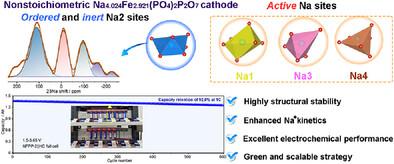Dual Regulation of Stability and Kinetics in Iron-Based Mixed Phosphate Cathode for All-Climate Sodium-Ion Batteries
IF 26
1区 材料科学
Q1 CHEMISTRY, PHYSICAL
引用次数: 0
Abstract
Iron-based mixed-phosphate Na4Fe3(PO4)2P2O7 (NFPP) is a representative cathode for sodium-ion batteries owing to its low cost and environmental compatibility. The behavior of sodium ions in NFPP is governed by four crystallographically distinguishable sodium sites, yet the underlying mechanism for occupation sites and diffusion kinetics remains not fully understood. Herein, a scalable synthesis strategy for NFPP materials with tunable local structures is proposed by controlling the iron valence during preparation. The nonstoichiometric Na4.024Fe2.921(PO4)2P2O7 strikes an optimal balance between the ordering and proportion of inert sodium ions. These ordered inert sodium ions act as structural pillars, providing markedly enhanced stability compared to disordered counterparts. The optimized sodium environment leads to a synergistic enhancement of both thermal stability and sodium ionic kinetics. The cathode delivers a remarkable rate performance and cycling stability (90.7% capacity retention after 10,000 cycles). This exceptional stability is corroborated by a small lattice volume variation of 4.18% upon desodiation. Moreover, cylindrical full cells assembled with kilogram-scale Na4.024Fe2.921(PO4)2P2O7 cathode and a hard carbon anode demonstrate excellent performance across a wide temperature range from −40 to 45 °C. This work establishes the critical interplay between local environment and electrochemical properties, offering valuable insights for the design of advanced cathode materials.

全天候钠离子电池铁基混合磷酸盐正极稳定性和动力学的双重调控
铁基混合磷酸Na4Fe3(PO4)2P2O7 (NFPP)具有成本低、环境相容性好等优点,是钠离子电池的代表性阴极材料。钠离子在NFPP中的行为是由四个晶体学上可区分的钠位点控制的,但其占据位点和扩散动力学的潜在机制仍未完全了解。本文通过控制制备过程中的铁价,提出了一种局部结构可调的NFPP材料的可扩展合成策略。非化学计量Na4.024Fe2.921(PO4)2P2O7在惰性钠离子的有序和比例之间达到了最佳平衡。这些有序的惰性钠离子作为结构支柱,与无序的对应物相比,提供了显著增强的稳定性。优化的钠环境导致热稳定性和钠离子动力学的协同增强。阴极具有出色的倍率性能和循环稳定性(10,000次循环后容量保持率为90.7%)。这种特殊的稳定性得到了脱酸后晶格体积变化4.18%的证实。此外,由公斤级Na4.024Fe2.921(PO4)2P2O7阴极和硬碳阳极组装的圆柱形全电池在−40至45°C的宽温度范围内表现出优异的性能。这项工作建立了局部环境和电化学性能之间的关键相互作用,为设计先进的阴极材料提供了有价值的见解。
本文章由计算机程序翻译,如有差异,请以英文原文为准。
求助全文
约1分钟内获得全文
求助全文
来源期刊

Advanced Energy Materials
CHEMISTRY, PHYSICAL-ENERGY & FUELS
CiteScore
41.90
自引率
4.00%
发文量
889
审稿时长
1.4 months
期刊介绍:
Established in 2011, Advanced Energy Materials is an international, interdisciplinary, English-language journal that focuses on materials used in energy harvesting, conversion, and storage. It is regarded as a top-quality journal alongside Advanced Materials, Advanced Functional Materials, and Small.
With a 2022 Impact Factor of 27.8, Advanced Energy Materials is considered a prime source for the best energy-related research. The journal covers a wide range of topics in energy-related research, including organic and inorganic photovoltaics, batteries and supercapacitors, fuel cells, hydrogen generation and storage, thermoelectrics, water splitting and photocatalysis, solar fuels and thermosolar power, magnetocalorics, and piezoelectronics.
The readership of Advanced Energy Materials includes materials scientists, chemists, physicists, and engineers in both academia and industry. The journal is indexed in various databases and collections, such as Advanced Technologies & Aerospace Database, FIZ Karlsruhe, INSPEC (IET), Science Citation Index Expanded, Technology Collection, and Web of Science, among others.
 求助内容:
求助内容: 应助结果提醒方式:
应助结果提醒方式:


